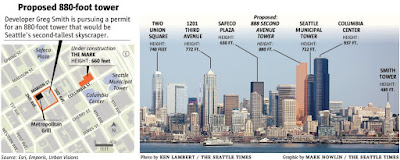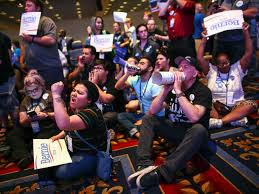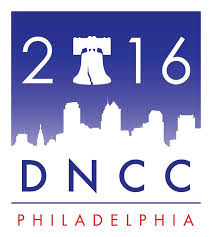http://www.latimes.com/nation/la-na-seattle-skyscraper-20160204-story.html
 |
Wilshire Grand Tower under construction
Los Angeles, California
commons.wikimedia.org |
Hello Everyone:
Welcome to a new week with new things to talk about. Today we are going to talk about new skyscraper developments on the West Coast of the United States. It seems that the "Left Coast" has caught the "who can build the tallest building" fever. Rick Anderson in his article, "New skyscrapers vie for West Coast's 'tallest' title in the
Los Angeles Times, writes about the latest entrants into the "how high is high" contest. This mini-boom of skyscrapers reflects a stronger economy, the demand for luxury residences, and the edifice complex has created a competition for who has the biggest shaft. To wit, when the Wilshire Grand Tower is completed in 2017, it will eclipse the 1,018 foot, 73-story U.S. Bank Tower in Downtown Los Angles, the currently the tallest building on the West Coast. However, the Wilshire Grand Tower may be dwarfed by a planned skyscraper development in Seattle, Washington.
 |
Proposed Seattle Tower
Seattle, Washington
seattletimes.com |
Rick Anderson writes, "Developers of a Seattle tower, in their city application, have sought what they called a height 'sweet spot'-between 1,050 and 1,150 feet-to gain matchless views of the region's soaring topography, Mt. Rainer and the snow-capped Olympic Mountains." Not only is bigger better, bigger is breathtaking.
Bigger is better, on steroids, was the message conveyed when the world's tallest building, the 163-story Burj Khalifa in Dubai, United Arab Emirates, opened in 2010. The internationally recognized tower, the 2,722-foot edifice resembles a stacked pyramid of coins, is the current holder of every imaginable height record, "...including world's highest nightclub (143rd floor), world's highest mosque (138th floor) and the fastest elevator (40 mph). From its observation deck, you can see Iran." Bigger is better is not on the mind of West Coast developers, specifically 1,700 feet smaller, still taller than they have ever built.
 |
Salesforce Tower
San Francisco, California
salesforcetower.com |
San Francisco, not content with watching their rival city Los Angeles take the title of the West Coast's tallest building, is poised to snatch the tallest tower title next year with the completion of the 1,070-foot Salesforce Tower, beating the U.S. Bank Tower by 52-feet. The glass walled skyscraper will hover over the "$4.5-billion Transbay Transit Center, the city's new South of Market transit hub." The Transbay Transit Center is the proposed endpoint of the proposed high-speed rail line to and from Los Angeles. The Transit Center is trumpeted as the "Grand Central Station of the West."
 |
Wilshire Grand Tower
Los Angeles, California
skyscraper center.com |
However, Los Angeles is not conceding to its Bay Area competitor. When completed, the Wilshire Grand Center will stand at 1,100-feet (including a 100-foot spire), "...a $1.2-billion, mixed-use office/hotel project in the Financial District, is also set to be completed next year,..." A tapered glass-wall high rise, being developed by Korean Air, "...will be topped by a domed 'sky lobby' with views of the Southland." It will be 30-feet taller than the Salesforce Tower and earn the title, according to the developers, of "the tallest building west of the Mississippi." For now.
 |
4/C Tower rendering
LMN Architects
Seattle, Washington
architect.com |
In development is the 4/C Tower, the West Coast's first 100-plus high rise in Seattle. It would beat Wilshire Grand by a paltry 11-feet. What is driving the race for how high is high? Simply, demand. According to Jason Barr, an associate economics professor at Rutgers University, told Rick Anderson,
The Wilshire Grand Center and 4/C tower in Seattle are going to be mixed-use projects, with some combination of apartments, hotels, office and shopping...So given the favorable climate for these high-end mixed uses, and the cache, that being 'tallest' brings to the market, I would say that the appearance of these buildings suggests that developers are trying to exploit a demand opportunity.
Another factor in the demand is the prestige of sublime panoramas that holds an allure for developers and clients. Prof. Barr, the author of
Building the Skyline: The and Growth of Manhattan's Skyscrapers, continued,
 |
Golden Gate Bridge with the TransAmerican Pyramid
San Francisco, California
images-of-america.photoshelter.com |
Super-tall projects can earn the developers premiums above more typical high-rise buildings if they convey some useful information or provide other services not available in other building.
In the case of offices, high-powered firms are often willing to pay the higher rents in these buildings because it advertises their profitability. In the case of luxury condos, very wealthy residents are also willing to pay a premium to live in these buildings, as a form of conspicuous consumption.
Another factor in the race to build tall is advanced construction technologies that have made higher and higher more feasible, taller, and safer, according to Jason Gabel, a spokesperson for the Council on Tall Buildings and Urban Habitat in Chicago. For example,
Super high-strength concrete is a major advancement that provides high strength, high stability, high pumping performance, low heat, low shrinkage, low cost, self-curing, self compacting and self-leveling...This material has been instrumental in realizing tall buildings in very active seismic regions, as it provides superior performance against lateral loads.
Rick Anderson observes, "Perhaps more than anything else, it is the statement implied by an edifice that looms over an entire cityscape."
 |
Los Angeles skyline
Los Angeles, California
en.wikipedia.org |
Jason Gabel continued.
Architecture is extremely communicative...and building 1,000-plu-foot is sending a very clear message to the rest of the country and around the world that these are successful, bustling, energetic places to to live. So there is definitely a 'look at us' element to the phenomenon as well.
To date, the proposed Seattle high rise could become the new West Coast height king as soon as 2018. The plans include 1,200 luxury residences, 150 hotel rooms, and 163,00 square feet of retail and commercial space.
In there application to the City of Seattle, the Miami, Florida-based developer Crescent Heights described it,
The scale of this building is actually related more to creating the appropriate amount of space-through a broad mix of uses-to activate and animate the neighborhood...
 |
Smith Tower
Seattle, Washington
en.wikipedia.org |
The proposed 4/C Tower eventually would grow to 102 stories on a narrow lot, just blocks from the West's tallest tower, a century ago, the 42-story Smith Tower, built by typewriter magnet L.C. Smith of Smith-Corona. L.C. Smith never got to see the building when it was completed in 1914-he died before it was finished. The tower kept its tallest building crown for about a half century until 1962, when another Seattle landmark beat it-the Space Needle. The Space Needle was built for the Seattle World's Fair and topped out at 665-feet. Today, at a tiny just under 500-feet, the Smith Tower gamely juts out among the sea of contemporary glass and steel high rises, at least 13 of which are taller and built to last only few decades.
Rick Anderson writes, "If Seattle is to surpass the 100-story mark, however, it must first over come Federal Aviation Administration objections. The agency told the developer the very reason for building the skyscraper is the reason it can't be built: it's too tall."
In January, the FAA issued a 'notice of presumed hazard" to Crescent Height, declaring "that a building that high on the hilly downtown parcel now occupied by a parking garage
would have an adverse physical or electromagnetic interference effect upon navigable air space or air navigation facilities.
 |
4/C with the Smith Tower in the foreground
Seattle, Washington
skyscraper city.com |
This complication was similar to the one faced by Seattle mega-developer Martin Selig, who opened the former-tallest skyscraper in the West. the 76-story, 943-foot Columbia Center in 1985. Mr. Anderson writes, "He wanted to go higher, but the FAA objected and Selig backed off." Four years, the Central Library Tower (renamed the U.S. Bank Tower) in Los Angeles beat it.
Crescent Heights remains optimistic, thinking that being a possible obstacle to air traffic to nearby Boeing Field can be overcome. Los Angeles-based developer spokesperson Christina Disney issued a statement referring the FAA notice,
...a standard, business-as-usual review process which the FAA applies to all tall buildings to downtown Seattle...Once complete, we anticipate that that a determination of " no hazard will be reached.
 |
"How they stack up"
anmengineering.com |
Sonny Kahn, the Miami billionaire who runs Crescent Height,
is
on somewhat of a streak of high-rise residential proposal around the nation, Mr. Gabel told Mr. Anderson. This streak includes a 39-story Century City residential development in West Los Angeles. The company said it intends to create
an iconic building in Seattle that redefines the skyline and changes the way we live. work and play downtown.
For critics, downsizing is more important. The snarky phallic comments and symbols (including the one made at the top of the post) in the Seattle media and by attendees at public hearings referred to the building's height and design as
a long, white middle finger sticking it to the city. However, the tall, taller, tallest buildings, enabled by innovations in design and construction techniques, are really setting themselves up for all sorts of comments but the market demands them. Prof. Barr told Mr. Anderson,
My research shows that condo buyers in New York City are willing to pay nearly 1% more for each floor up, on average-thus 25 stories higher can mean up to 25% more income. Office rent premiums, I find rise around 0.6% per floor, or about 6% for every 10 floors higher. Furthermore, developers are increasing the ceiling heights in luxury condos because tall ceilings are in vogue-and new technology allow them to provide them more efficiently.
One World Trade Center in New York, the country's tallest building, is 1,776 feet. Rick Anderson speculates, "Is there a 2,000-plus foot skyscraper in America's future?" Jason Barr does not believe this to be the case, "citing government reluctance, land and labor costs, and zoning regulations. He said,
In short...the economic, political and social forces do seem to exit in the U.S. to favor a 200-story building.
At least, for now.



















































